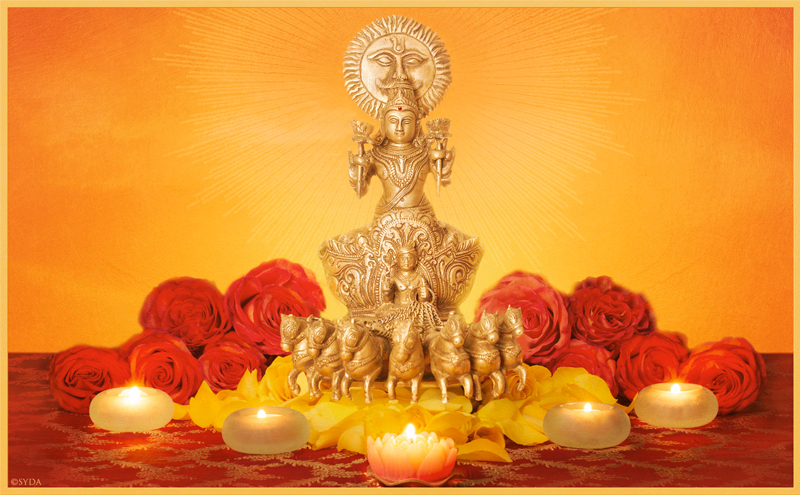Lord Surya: The Effulgence of Pure Consciousness

An Exposition by Maitreya Larios
Lord Sūrya, the sun, is revered throughout the Vedas, the oldest scriptures of India. He is addressed in them as Mitra, Savitṛ, Pūṣan, Āditya, among other names, each of which describes a particular aspect of his divinity.
The ancient hymns of the Ṛg Veda describe Lord Sūrya as the giver and sustainer of all life. He is lauded as having a golden body and radiating a golden splendor. In other Vedic hymns, he is portrayed as the guardian and preserver of nature, and because of his generous and benevolent effulgence, he is often called Mitra, “friend.”
For millennia, practicing Brahmins in India have without fail invoked Lord Sūrya three times a day—in the morning, at noon, and at sunset—in a ritual called sandhyāvandana. In this ritual, they worship Lord Sūrya as Savitṛ, “the vivifier,” by reciting the Gāyatrī mantra to become free from all suffering and attain great joy. As the sun gives all-pervasive light, by invoking Lord Sūrya, obstacles are removed, and he imparts knowledge, wisdom, and liberation.
In the scriptures, the sun as dispeller of darkness is explicitly linked to the power of sight, to visual perception, and ultimately to knowledge. Lord Sūrya is referred to as the “eye of knowledge” and is equated with the Guru Principle, which dissipates the ignorance that obscures awareness of our own divinity. By invoking Lord Sūrya, one invites the radiant light of the Guru to shine forth within as the sun of Consciousness.
On the Siddha Yoga path, we learn to honor Lord Sūrya as the source of light and vitality in the world and as an embodiment of the inner effulgence that is our true nature. One of the ways to invoke Lord Sūrya is by the same means the Brahmins employ: by reciting the Sūrya Gāyatrī mantra, which is also known as the Sāvitrī or Ādi Gāyatrī mantra or even just the Gāyatrī. We are to meditate on Lord Sūrya while listening to or reciting this powerful and traditional Vedic mantra.
In the scriptures it is said that Lord Sūrya welcomes the offering of the Gāyatrī mantra at sunrise. This offering expands the capacity of Lord Sūrya’s luminosity to dissipate darkness, allegorically depicted in the scriptures as demons that attempt to devour him every night. With this enhanced luminosity, Lord Sūrya easily bursts forth each day as the light of dawn. Similarly, Siddha Yogis engage in spiritual practices to drive away the darkness of limitations and ignorance of their true nature while invoking the fullness of divine light to rise within.
The scriptures describe Lord Sūrya as riding through the heavens in his one-wheeled chariot with twelve spokes, the one wheel corresponding to the orb of the sun. His chariot is pulled by seven horses that represent the seven main meters in which the holy Vedas were composed. Lord Sūrya is said to follow the goddess Uṣas, who is also seen as the personification of dawn and who drives away darkness and evil. As the dawn, Uṣas is the power of awakening and auspicious beginnings. She impels us to act and is associated with breath and the life of all living creatures.
Lord Sūrya is also called Kha-ga, “sky-goer,” and because, in riding the sky, he creates day and night, this celestial being is also associated with time, the seasons, and other natural cycles. The seven horses that pull his chariot represent the seven days of the week, and the twelve spokes of the chariot wheel, the months of the year.
Another iconographic aspect is that Lord Sūrya is represented holding a lotus flower in each of his two hands. The lotus is a symbol of the creative force of nature and its cycles, therefore of time. Like the wheel (cakra) of his chariot, the lotus flower is often described as having twelve petals representing each of the months of the year. Though time marches on, the light responsible for its advancement remains unchanged. This light that drives the turning of time is the same light that illuminates us from within.
Like the lotus, the wheel also represents the nature of dharma, the supreme order of the universe, which constantly revolves as it advances on its course. The hub at the axis of the wheel, however, remains in complete stillness, a symbol for the stillness from which everything in creation emanates, like the rays that emanate from the sun.
These are some of the ways by which we can invoke the grace of Lord Sūrya: by meditating on the rising sun; by practicing the haṭha yoga āsana sequence Sūrya Namaskar; by reading stories of him from the Indian epics such as the Mahabharata; by chanting his mantra and singing his many hymns such as the Sūrya Gāyatrī mantra, the Sūrya Stotram, the Sūryāṣṭakam, and Ādityahṛdayam. Seekers can find these many ways to invoke Lord Sūrya here on the Siddha Yoga path website.



